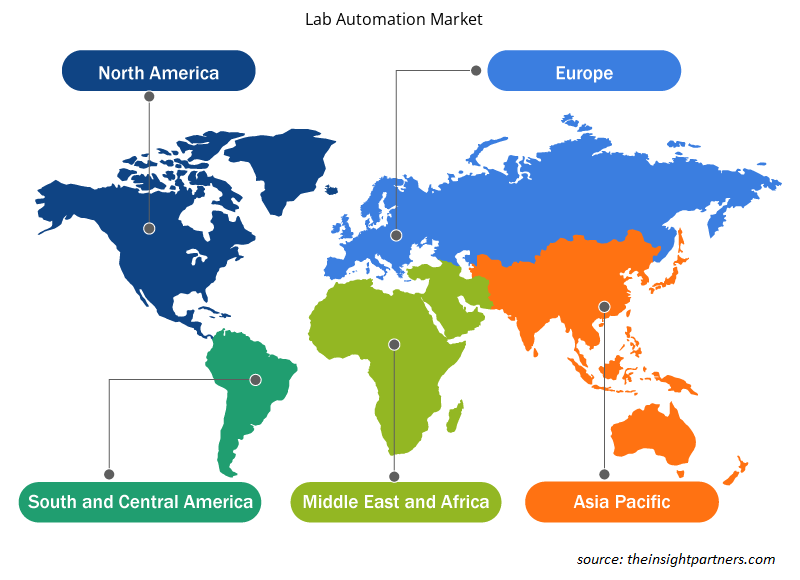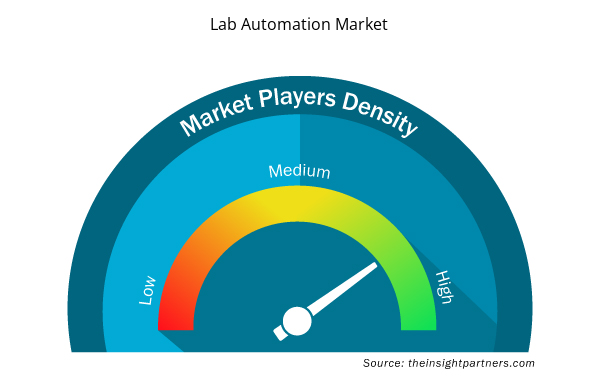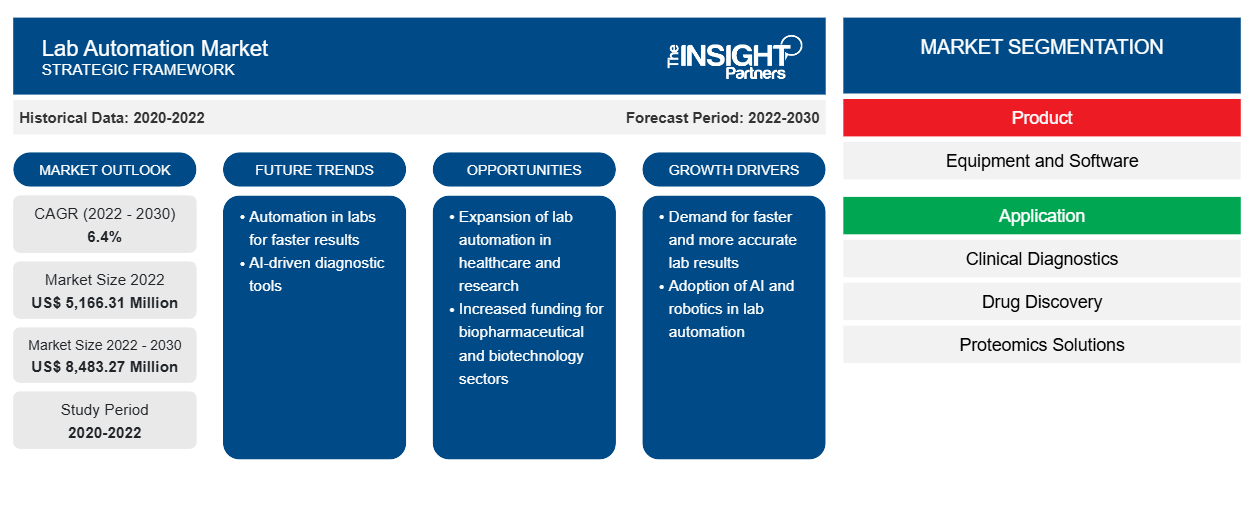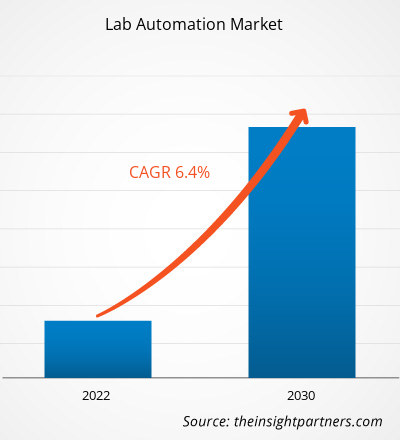[調査レポート] ラボ自動化市場規模は、2022年の51億6,631万米ドルから2030年には84億8,327万米ドルに成長すると予想されており、2022年から2030年にかけて6.4%のCAGRを記録すると予想されています。
ラボ自動化市場の洞察とアナリストの見解:
ラボに自動化を統合して、新しい強化されたラボプロセスを可能にすることをラボ自動化といいます。ラボ自動化技術の最もよく知られた用途は、ラボロボットです。さらに、ラボ自動化には、ラボでの研究の有効性を実現、加速、改善するために使用される自動化されたラボ機器、デバイス、ソフトウェアアルゴリズム、および方法論の幅広い範囲が含まれます。ラボ自動化市場分析に基づくと、ラボ自動化市場を牽引する主な要因は、ラボ自動化によって提供されるアプリケーションと利点の増加と、成長する製薬業界です。ただし、高額の資本投資によるラボ自動化の採用の制限が、ラボ自動化市場の成長を妨げています。
成長の原動力と制約:
バイオテクノロジー、医薬品、臨床診断、学術研究、環境試験は、ラボ自動化の増加が見られた主要産業の一部です。ラボ手順における効率、精度、スループットの向上に対する要件が、ラボ自動化の需要を促進しています。自動化技術の使用は、科学研究開発の生産性と品質に大きな影響を与える可能性のあるさまざまな利点を提供します。さまざまな主要な利点と用途には、ハイスループットスクリーニング、サンプルの準備と処理、データ管理と統合、ワークフローの最適化、柔軟性とカスタマイズ、品質管理と保証、リソースの最適化、長期的なコスト削減、危険な化学物質や生物学的材料の手作業による取り扱いの削減、ラボの容量と機能の拡張などがあります。このように、ラボ自動化はますます有利になり、さまざまな業界で科学研究開発をどのように変革できるかが強調されています。技術の発展に伴い、ラボ自動化が増加し、科学的イニシアチブの効率と革新が促進されると予想されます。
しかし、バイオテクノロジーや製薬業界をはじめとするさまざまな企業は、高額な設備投資のためにラボ自動化の導入に大きな問題を抱えています。ラボ自動化は、効率、精度、スループットの向上など、さまざまなメリットをもたらしますが、自動化システムを導入するための初期コストは、特定の企業にとって負担が大きすぎる場合があります。機器コスト、インフラストラクチャ要件、統合とカスタマイズ、メンテナンスとサポート、高度な専門知識要件、技術陳腐化のリスクなど、さまざまな要因がラボ自動化に必要な高額な設備投資に寄与しています。たとえば、Retisoft Inc. によると、小型の自動化ロボットシステムの価格帯は 100,000 米ドルから 300,000 米ドルです。ただし、より複雑で大規模なラボ自動化システムは、100 万ドルを超えることもよくあります。したがって、ラボ自動化に必要な高額な設備投資は、多くのバイオテクノロジーおよび製薬会社、特に資金が限られている小規模または新興の組織によるラボ自動化の導入を妨げる可能性があります。したがって、上記の要因は、世界のラボ自動化市場の成長を妨げる可能性があります。
要件に合わせてレポートをカスタマイズする
このレポートの一部、国レベルの分析、Excelデータパックなど、あらゆるレポートを無料でカスタマイズできます。また、スタートアップや大学向けのお得なオファーや割引もご利用いただけます。
- このレポートの主要な市場動向を入手してください。この無料サンプルには、市場動向から見積もりや予測に至るまでのデータ分析が含まれます。
レポートのセグメンテーションと範囲:
世界のラボ自動化市場レポートは、製品、アプリケーション、およびエンドユーザーに基づいてセグメント化されています。製品に基づいて、ラボ自動化市場は機器とソフトウェアに分かれています。機器に基づいて、市場は自動化ワークステーション、マイクロプレートリーダー、ロボットシステム、既製の自動化作業セル、自動保管および検索システム(ASRS)などに細分化されています。ソフトウェアに基づいて、市場は実験実行システム(LES)、実験情報管理システム(LIMS)、電子実験ノート(ELN)、および科学データ管理システム(SDMS)に細分化されています。アプリケーションに基づいて、ラボ自動化市場は臨床診断、創薬、プロテオミクスソリューション、ゲノミクスソリューションなどに区別されています。エンドユーザーに基づいて、ラボ自動化市場は製薬会社、病院および診断センター、教育および研究機関、および契約研究機関に分類されます。ラボ自動化市場レポートは、地理に基づいて、北米(米国、カナダ、メキシコ)、ヨーロッパ(ドイツ、フランス、イタリア、英国、ロシア、その他のヨーロッパ)、アジア太平洋(オーストラリア、中国、日本、インド、韓国、その他のアジア太平洋)、中東およびアフリカ(南アフリカ、サウジアラビア、UAE、その他の中東およびアフリカ)、南米および中米(ブラジル、アルゼンチン、その他の南米および中米)に分類されています。
セグメント分析:
製品に基づいて、ラボ自動化市場は機器とソフトウェアに分かれています。機器セグメントは2022年にラボ自動化市場で大きなシェアを占めました。ただし、ラボ自動化市場の予測に基づくと、ソフトウェアセグメントは2022年から2030年の間により高いCAGRを記録すると予想されます。
機器に基づいて、ラボ自動化市場は、自動化ワークステーション、液体処理システム、ロボットシステム、マイクロプレートリーダー、自動保管および検索システム(ASRS)などに細分化されています。
アプリケーションに基づいて、ラボ自動化市場は、臨床診断、創薬、 プロテオミクスソリューション、ゲノミクスソリューションなどに分類されます。創薬セグメントは、2022年にラボ自動化市場規模で最大のシェアを占めました。ただし、ラボ自動化市場予測に基づくと、臨床診断セグメントは2022年から2030年にかけて最高のCAGRを記録すると予想されます。
エンドユーザーに基づいて、ラボ自動化市場は、製薬会社、病院および診断センター、教育および研究機関、契約研究機関に分類されます。 2022年には、製薬会社セグメントがラボ自動化市場規模で最大のシェアを占めました。 ただし、ラボ自動化市場の予測に基づくと、病院および診断センターセグメントは、2022年から2030年の間に最高のCAGRを記録すると予想されます。
地域分析:
地理に基づいて、世界のラボ自動化市場は、北米、ヨーロッパ、アジア太平洋、南米および中米、中東およびアフリカの 5 つの主要地域に分類されます。
2022年、北米は世界のラボ自動化市場規模で最大のシェアを占めました。米国全土での医療インフラの発展と医療サービスへの支出の増加が、同国のラボ自動化市場を牽引しています。臨床試験、医薬品開発、生物医学研究におけるラボ自動化の使用は、ラボ自動化市場の成長に大きな影響を与えています。これらのシステムは、ほとんど監督や指示なしに長期間稼働することもできるため、研究者は主な仕事に集中でき、反復的な活動に費やす時間を減らすことができます。さらに、米国のメディケア・メディケイドサービスセンター(CMS)は、臨床検査改善修正条項(CLIA)に基づいて人間の実験室研究に関連する基準を採用しており、これによりラボ自動化市場の成長が促進されています。
ラボ自動化市場の地域別分析
予測期間を通じてラボ自動化市場に影響を与える地域的な傾向と要因は、Insight Partners のアナリストによって徹底的に説明されています。このセクションでは、北米、ヨーロッパ、アジア太平洋、中東およびアフリカ、南米および中米にわたるラボ自動化市場のセグメントと地理についても説明します。

- ラボ自動化市場の地域別データを入手
ラボ自動化市場レポートの範囲
| レポート属性 | 詳細 |
|---|---|
| 2022年の市場規模 | 51億6,631万米ドル |
| 2030年までの市場規模 | 84億8,327万米ドル |
| 世界のCAGR(2022年 - 2030年) | 6.4% |
| 履歴データ | 2020-2022 |
| 予測期間 | 2022-2030 |
| 対象セグメント | 製品別
|
| 対象地域と国 | 北米
|
| 市場リーダーと主要企業プロフィール |
|
ラボ自動化市場のプレーヤー密度:ビジネスダイナミクスへの影響を理解する
ラボ自動化市場は、消費者の嗜好の変化、技術の進歩、製品の利点に対する認識の高まりなどの要因により、エンドユーザーの需要が高まり、急速に成長しています。需要が高まるにつれて、企業は提供を拡大し、消費者のニーズを満たすために革新し、新たなトレンドを活用し、市場の成長をさらに促進しています。
市場プレーヤー密度とは、特定の市場または業界内で活動している企業または会社の分布を指します。これは、特定の市場スペースに、その規模または総市場価値と比較して、どれだけの競合相手 (市場プレーヤー) が存在するかを示します。
ラボ自動化市場で事業を展開している主要企業は次のとおりです。
- シーメンス ヘルシナーズ
- サーモフィッシャーサイエンティフィック
- アナリティク・イエナ GmbH+Co. KG
- ラボマンオートメーション株式会社
- BD
免責事項:上記の企業は、特定の順序でランク付けされていません。

- ラボオートメーション市場のトップキープレーヤーの概要を入手
業界の発展と将来の機会:
世界のラボ自動化市場で活動する主要企業が行っているさまざまな取り組みを以下に示します。
- 2023 年 5 月、Opentrons は、手頃な価格で簡単にプログラムできる革新的な液体処理ラボ ロボットである Opentrons Flex ロボットの発売を発表しました。このロボットにより、あらゆる規模のラボの競争条件が平等になり、高度なラボ自動化がこれまで以上に多くの研究者に利用できるようになります。Flex ロボットは、最先端のロボット工学と広大なオープンソース ソフトウェア エコシステムを組み合わせたものです。AI ツールと併用でき、新しいプロトコルを選択するためのほぼ無限の機能を備えています。
- 2023 年 3 月、Brooks Automation US, LLC は Aim Lab Automation Technologies Pty Ltd の買収を発表しました。Brooks による Aim Lab の買収は、ラボ自動化市場でより多くのソリューションを提供するという同社の拡張計画に沿ったものです。PreciseFlex 製品ソリューションにより、Brooks はライフサイエンス共同自動化市場をリードしています。この買収により、Brooks の臨床診断における地位は創薬を超えて高まりました。PreciseFlex により、Aim Lab は顧客により多くの機能、グローバルな展開、より緊密に協力する機会を提供します。
- 2023 年 2 月、Automata は新しいオープンな統合ラボ自動化プラットフォームである LINQ をリリースしました。LINQ プラットフォームには、自動化ツールが組み込まれた専用のラボベンチと、強力な社内ラボオーケストレーションソフトウェアが含まれています。その結果、ラボは、大型で複雑な機器のためのスペースを追加することなく、人間のタッチポイントの数を減らしながら、効率と精度を向上させることができます。
- 2023 年 1 月、BD (Becton, Dickinson and Company) は、BD Kiestra 微生物学ラボ ソリューション用のロボット トラック システムを発表しました。このシステムはラボの検体処理を自動化し、人的労力を最小限に抑えて待ち時間を短縮する可能性があります。新しい BD Kiestra 第 3 世代トータル ラボ自動化システムを使用すると、ラボはさまざまな BD Kiestra モジュールをリンクして、独自の適応性の高いトータル ラボ自動化構成を構築できます。また、ラボの変化するニーズに対応できるように拡張可能です。さまざまなトラック構成とマシンから選択することで、ラボは独自のワークフローと物理的なラボ スペースに合わせて自動化システムをカスタマイズできます。
- 2022 年 6 月、Insilico Medicine は AI が運営するロボット ラボを立ち上げました。これは、Insilico のエンドツーエンドの AI 駆動型創薬プラットフォームを現実世界に相互接続して拡張したものです。このラボは AI システムによって遠隔制御され、人間の科学者の代わりに自律誘導車両が実験を実行します。これらのロボットは、細胞培養、ハイスループット スクリーニング、次世代シーケンシング、細胞イメージング、ゲノム解析と予測を行います。
- 2021 年 5 月、ベックマン・コールターは DxA 5000 Fit の世界発売を発表しました。DxA 5000 Fit は、1 日あたり 5,000 件未満の検査を実施する中規模のラボに適合するように設計されたワークフロー自動化システムです。
競争環境と主要企業:
Siemens Healthineers、Thermo Fisher Scientific Inc、Analytik Jena GmbH+Co. KG、Labman Automation Ltd、BD、Brooks Automation Inc、bioMerieux SA、CrelioHealth Inc.、Danaher Corporation、および F. Hoffmann-La Roche Ltd は、ラボ自動化市場で活動する著名な企業です。これらの企業は、新しいテクノロジー、既存製品の進化、および地理的拡大に注力して、世界中で高まる消費者の需要に対応し、専門ポートフォリオの製品範囲を拡大しています。
- 過去2年間の分析、基準年、CAGRによる予測(7年間)
- PEST分析とSWOT分析
- 市場規模価値/数量 - 世界、地域、国
- 業界と競争環境
- Excel データセット



Report Coverage
Revenue forecast, Company Analysis, Industry landscape, Growth factors, and Trends

Segment Covered
This text is related
to segments covered.

Regional Scope
North America, Europe, Asia Pacific, Middle East & Africa, South & Central America

Country Scope
This text is related
to country scope.
Trends and growth analysis reports related to Technology, Media and Telecommunications : READ MORE..
The List of Companies - Lab Automation Market
- Siemens Healthineers
- Thermo Fisher Scientific Inc
- Analytik Jena GmbH+Co. KG
- Labman Automation Ltd
- BD
- Brooks Automation Inc
- bioMerieux SA
- CrelioHealth Inc.
- Danaher Corporation
- F. Hoffmann-La Roche Ltd
The Insight Partners performs research in 4 major stages: Data Collection & Secondary Research, Primary Research, Data Analysis and Data Triangulation & Final Review.
- Data Collection and Secondary Research:
As a market research and consulting firm operating from a decade, we have published and advised several client across the globe. First step for any study will start with an assessment of currently available data and insights from existing reports. Further, historical and current market information is collected from Investor Presentations, Annual Reports, SEC Filings, etc., and other information related to company’s performance and market positioning are gathered from Paid Databases (Factiva, Hoovers, and Reuters) and various other publications available in public domain.
Several associations trade associates, technical forums, institutes, societies and organization are accessed to gain technical as well as market related insights through their publications such as research papers, blogs and press releases related to the studies are referred to get cues about the market. Further, white papers, journals, magazines, and other news articles published in last 3 years are scrutinized and analyzed to understand the current market trends.
- Primary Research:
The primarily interview analysis comprise of data obtained from industry participants interview and answers to survey questions gathered by in-house primary team.
For primary research, interviews are conducted with industry experts/CEOs/Marketing Managers/VPs/Subject Matter Experts from both demand and supply side to get a 360-degree view of the market. The primary team conducts several interviews based on the complexity of the markets to understand the various market trends and dynamics which makes research more credible and precise.
A typical research interview fulfils the following functions:
- Provides first-hand information on the market size, market trends, growth trends, competitive landscape, and outlook
- Validates and strengthens in-house secondary research findings
- Develops the analysis team’s expertise and market understanding
Primary research involves email interactions and telephone interviews for each market, category, segment, and sub-segment across geographies. The participants who typically take part in such a process include, but are not limited to:
- Industry participants: VPs, business development managers, market intelligence managers and national sales managers
- Outside experts: Valuation experts, research analysts and key opinion leaders specializing in the electronics and semiconductor industry.
Below is the breakup of our primary respondents by company, designation, and region:

Once we receive the confirmation from primary research sources or primary respondents, we finalize the base year market estimation and forecast the data as per the macroeconomic and microeconomic factors assessed during data collection.
- Data Analysis:
Once data is validated through both secondary as well as primary respondents, we finalize the market estimations by hypothesis formulation and factor analysis at regional and country level.
- Macro-Economic Factor Analysis:
We analyse macroeconomic indicators such the gross domestic product (GDP), increase in the demand for goods and services across industries, technological advancement, regional economic growth, governmental policies, the influence of COVID-19, PEST analysis, and other aspects. This analysis aids in setting benchmarks for various nations/regions and approximating market splits. Additionally, the general trend of the aforementioned components aid in determining the market's development possibilities.
- Country Level Data:
Various factors that are especially aligned to the country are taken into account to determine the market size for a certain area and country, including the presence of vendors, such as headquarters and offices, the country's GDP, demand patterns, and industry growth. To comprehend the market dynamics for the nation, a number of growth variables, inhibitors, application areas, and current market trends are researched. The aforementioned elements aid in determining the country's overall market's growth potential.
- Company Profile:
The “Table of Contents” is formulated by listing and analyzing more than 25 - 30 companies operating in the market ecosystem across geographies. However, we profile only 10 companies as a standard practice in our syndicate reports. These 10 companies comprise leading, emerging, and regional players. Nonetheless, our analysis is not restricted to the 10 listed companies, we also analyze other companies present in the market to develop a holistic view and understand the prevailing trends. The “Company Profiles” section in the report covers key facts, business description, products & services, financial information, SWOT analysis, and key developments. The financial information presented is extracted from the annual reports and official documents of the publicly listed companies. Upon collecting the information for the sections of respective companies, we verify them via various primary sources and then compile the data in respective company profiles. The company level information helps us in deriving the base number as well as in forecasting the market size.
- Developing Base Number:
Aggregation of sales statistics (2020-2022) and macro-economic factor, and other secondary and primary research insights are utilized to arrive at base number and related market shares for 2022. The data gaps are identified in this step and relevant market data is analyzed, collected from paid primary interviews or databases. On finalizing the base year market size, forecasts are developed on the basis of macro-economic, industry and market growth factors and company level analysis.
- Data Triangulation and Final Review:
The market findings and base year market size calculations are validated from supply as well as demand side. Demand side validations are based on macro-economic factor analysis and benchmarks for respective regions and countries. In case of supply side validations, revenues of major companies are estimated (in case not available) based on industry benchmark, approximate number of employees, product portfolio, and primary interviews revenues are gathered. Further revenue from target product/service segment is assessed to avoid overshooting of market statistics. In case of heavy deviations between supply and demand side values, all thes steps are repeated to achieve synchronization.
We follow an iterative model, wherein we share our research findings with Subject Matter Experts (SME’s) and Key Opinion Leaders (KOLs) until consensus view of the market is not formulated – this model negates any drastic deviation in the opinions of experts. Only validated and universally acceptable research findings are quoted in our reports.
We have important check points that we use to validate our research findings – which we call – data triangulation, where we validate the information, we generate from secondary sources with primary interviews and then we re-validate with our internal data bases and Subject matter experts. This comprehensive model enables us to deliver high quality, reliable data in shortest possible time.


 このレポートの無料サンプルを入手する
このレポートの無料サンプルを入手する